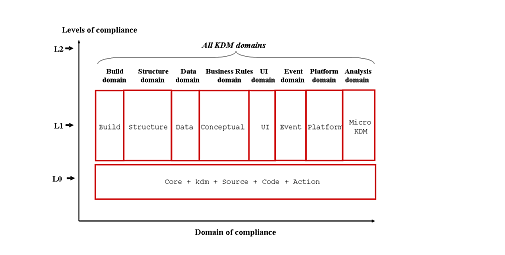KDM Domains
Separate facts of knowledge discovery in enterprise application in KDM are grouped into several KDM domains (refer to See - Domains and levels of KDM compliance.). Each KDM domain consists of a single KDM package which defines meta-model elements to represent particular aspects of the system under study. KDM domains correspond to the well-known concept of architecture views. For example, the Structure domain enables users to discover architectural elements of source code from the system under study, while the Business Rules domain provides users with behavioral elements of the same system such as features or process rules.
The following domains of knowledge have been identified as the foundation for defining compliance in KDM: Build, Structure, Data, Business Rules, UI, Event, Platform and micro KDM
From the user's perspective, this partitioning of KDM means that they need only to be concerned with those parts of the KDM that they consider necessary for their activities. If those needs change over time, further KDM domains can be added to the user's repertoire as required. Hence, a KDM user does not have to know the full meta-model to use it effectively. In addition, most KDM domains are partitioned into multiple increments, each adding more knowledge capabilities to the previous ones. This fine-grained decomposition of KDM serves to make the KDM easier to learn and use, but the individual segments within this structure do not represent separate compliance points. The latter strategy would lead to an excess of compliance points and result to the interoperability problems described above. Nevertheless, the groupings provided by KDM domains and their increments do serve to simplify the definition of KDM compliance as explained below.
How to Read this Specification
The rest of this document contains the technical content of this specification.
Chapter 7. Specification overview
Provides design rationale for the KDM specification
Chapter 8. KDM
Gives the overview of the packages of KDM
Part 1. The KDM Infrastructure Layer
Chapter 9. Core package
Describes foundation constructs for creating and describing meta-model classes in other KDM packages. Classes and associations of the Core package determine the structure of KDM models, provide meta-modeling services to other classes and define fundamental constraints.
Chapter 10. kdm package
Describes the key infrastructure elements that determine patterns for constructing KDM models and integrating them. This package defines several static elements that are shared by all KDM models. This package determines the queries against KDM models.
Chapter 11. Source package
This package describes meta-model elements for specifying the linkage between the KDM model artifacts and their physical implementations in the artifacts of existing software. Elements of the Source package allow viewing the source code, corresponding to KDM model elements.
Part 2. The Program Elements Layer
Chapter 12. Code package
Describes meta-model elements that capture programming artifacts as provided by programming languages, such as data types, procedures, macros, prototypes, templates, etc.
Chapter 13. Action package
Describes the meta-model elements related to the behavior of applications. Action package defines detailed endpoints for most KDM relations. The key element related to behavior is a KDM action. Other packages depend on the Action package to use actions in further modeling aspects of existing applications such as features, scenarios, business rules, etc.
Chapter 14. Micro KDM
Describes the guidelines and constraints for semantically precise KDM representations.
Part 3. The Runtime Resources Layer
Chapter 15. Platform package
Describes the meta-model elements for representing operating environments of existing software systems. Application code is not self-contained, as it depends not only on the selected programming language, but also on the selected Runtime platform. Platform elements determine the execution context for the application. Platform package provides meta-model elements to address the following:
-
Resources that Runtime platforms provide to components
-
Services that are provided by the platform to manage the life-cycle of each resource
-
Control-flow between components as it is determined by the platform
-
Error handling across application components
-
Integration of application components
The Platform package focuses on the logical aspects of the operating environments of existing applications, while the Runtime package further addresses the physical aspects of operating environments, such as deployment.
Chapter 16. UI package
Describes the meta-model elements to represent knowledge related to user interfaces, including their logical composition, sequence of operations, etc.
Chapter 17. Event package
Describes meta-model elements that represent basic elements related to behavior of applications in terms of events, messages and responses.
Chapter 18. Data package
Describes the Data domain of KDM, aiming primarily at databases and other ways of organizing persistent data in enterprise applications independent of a particular technology, vendor and platform.
Part 4. Abstractions Layer
Chapter 19. Structure package
Describes the meta-model elements for representing the logical organization of the software system in terms of logical subsystems, architectural layers, components and packages.
Chapter 20. Conceptual package
Describes the meta-model elements for representing business domain knowledge about existing applications in the context of other KDM views.
Chapter 21. Build package
Describes the meta-model elements for representing the artifacts involved in building the software system (the engineering view of the software system).
Acknowledgements
The following companies submitted and/or supported parts of this specification:
-
Allen Systems Group, Inc
-
BluePhoenix
-
EDS
-
Flashline
-
IBM
-
Klocwork, Inc.
-
KDM Analytics
-
SoftwareRevolution
-
Tactical Strategy Group, Inc
-
Unisys
The following persons were members of the core team that designed and wrote this specification: Nikolai Mansourov, Michael Smith, Djenana Campara, Larry Hines, William Ulrich, Howard Hess, Henric Gomez, Chris Caputo, Vitaly Khusidman, Barbara Errickson-Connor.
In addition, the following persons contributed valuable ideas and feedback that significantly improved the content and the quality of this specification: Pete Rivett, Adam Neal, Sumeet Malhotra, Jim Rhyne, Mark Dutra, Sara Porat, Fred Cummins, Manfred Koethe, Alena Laskavaia, Alain Picard.
